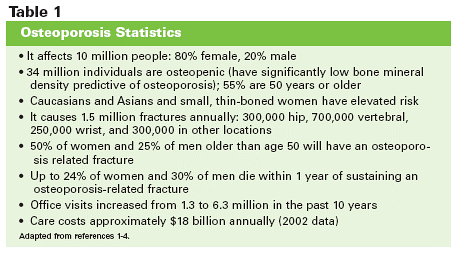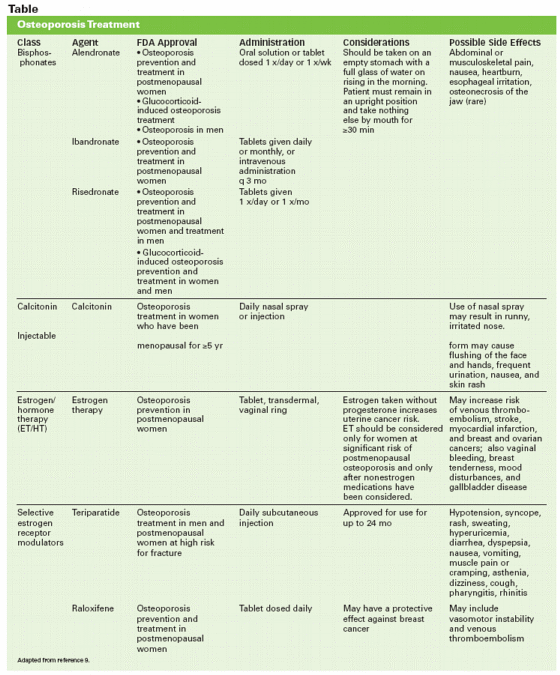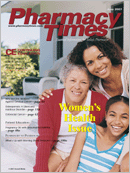Publication
Article
Pharmacy Times
Osteoporosis: A Silent and Insidious Disorder
Author(s):
The 2- to 3-month bone development process involves 2 stages: osteoclasts break down and remove old bone (resorption); and osteoblasts build new bone (remodeling). Before age 30, bone remodeling outpaces bone resorption, as bones form. Eventually, absorption outpaces remodeling, and low bone mineral density (BMD) and deterioration of bone tissue?in a word, osteoporosis (Table 11-4)?increase fracture risk.1,5
Among women, bone loss accelerates after menopause: up to 20% of female bone loss occurs during the first 5 postmenopausal years.2 Bone loss occurs more slowly in men until after age 65, when the rate becomes similar to that in women.6 Osteoporosis may be primary (age-related) or secondary (eg, arising from medication use or diseases such as Crohn?s disease or hyperparathyroidism).5
Risk Factors
Risk factors include increasing age, gender, ethnicity, body frame, and family history. Osteoporosis also is linked to inadequate calcium, vitamin D, and exercise; alcohol and tobacco use; and low estrogen levels in women and low testosterone levels in men. Additionally, risk increases with long-term glu-cocorticoid use and with the use of some anticonvulsants, barbiturates, gonadotropin-releasing hormone agents to treat endometriosis, aluminum-containing antacids, some antineoplastics, and excessive thyroid hormone.1
Testing
Osteoporosis is a silent disease. Although it frequently is diagnosed after fractures occur, height loss of >1 inch, back pain, spine curvature, or stooped posture also suggest osteoporosis and its possible consequences: multiple collapsed vertebrae and spine fractures.6 Dual-energy x-ray absorptiometry (DEXA) scan, the gold standard for measuring BMD, can detect bone loss of <1%.7 Although less precise than DEXA scans, peripheral quantitative ultrasound of the calcaneus (heel bone) often is used for screening.8
Treatment
Estrogen therapy, once the mainstay for slowing age-related bone thinning, is still considered a viable treatment. The FDA recommends hormone treatment, employing the smallest doses possible after carefully assessing patient-specific benefits and risks.4
Antiresorption Agents
Oral bisphosphonates decrease bone resorption and are today?s preferred treatment.4 Pharmacists should counsel patients pointedly that they must continue to take calcium and vitamin D while taking bisphosphonates. Raloxifene, a selective estrogen receptor modulator approved for use in postmenopausal women, slows bone loss and reduces spine (but not hip) fractures. Calcitonin, a synthetic thyroid hormone, increases spinal bone density, but its impact on fractures remains unknown.
Bone-remodeling Agents
Teriparatide, a parathyroid hormone analog, is the only agent specially approved for stimulating new bone growth. The FDA recommends using it for >2 years until the long-term impact has been assessed. Combination therapy with teriparatide is not recommended.4 The bisphosphonates pamidronate and zoledronic acid are given intravenously only; etidronate and tilu-dronate are used for other bone-resorption concerns (Paget?s disease, heterotopic ossification, etc) but not garden-variety osteoporosis; and min-odronate is investigational.4,9 Researchers are still investigating the ideal treatment duration. Long-term bisphosphonate use may inhibit microdamage repair, cause excessive mineralization, and increase micro-cracks.4,9

Patient Counseling
With younger patients, pharmacists should highlight prevention strategies ubiquitously, because prevention ideally begins before age 30 when bone is growing. Older adults can minimize risk by increasing vitamin D/calcium intake and exercise, quitting smoking, reducing or eliminating alcohol consumption, and avoiding medications linked to bone loss. Additionally, environmental modifications will decrease fracture risk (eg, installing grab bars in bathrooms, removing slippery area rugs, increasing lighting).
Research has demonstrated that calcium and vitamin supplements reduce hip fractures by 29%, but requirements change with age.4 People between 19 and 50 years of age require 1000 mg of calcium daily; those >50 require 1200 mg.3 A balanced diet generally provides recommended levels, but, when supplements are required, calcium carbonate and calcium citrate commonly are used.
Calcium absorption requires vitamin D. Usually, 15 minutes of sunshine on the face and/or forearms daily is sufficient, but people who are housebound or living in northern climates may require supplements. The Institute of Medicine recommends 400 international units (IU) of vitamin D for those 51 to 70 years old and 600 IU for those >70.6
Final Thought
Myths about osteoporosis perpetuate, including the stereotype that only those with hunched postures have the disease. In 2002, President Bush declared 2002 to 2011 as National Bone and Joint Decade, outlining numerous initiatives and urging professionals to ?raise awareness about musculoskele-tal disorders.?(10)Osteoporosis, a silent and insidious disorder, needs to be brought to the forefront of patient awareness.
Ms. Wick is a senior clinical research pharmacist at the National Cancer Institute, National Institutes of Health, Bethesda, Md. The views expressed are those of the author and not those of any government agency.

References
1. National Institute of Arthritis and Musculoskeletal and Skin Diseases. Osteoporosis Overview. Available at: www.niams.nih.gov/bone/hi/overview.htm. Accessed March 20, 2007.
2. National Osteoporosis Foundation. Fast Facts. Available at: www.nof.org/osteoporosis/diseasefacts.htm. Accessed March 21, 2007.
3. Bennett B. The low-down on osteoporosis. National Institutes of Health. Word on Health. December 2003. Available at: www.nih.gov/news/WordonHealth/dec2003/osteo.htm. Accessed March 20, 2007.
4. Mulder JE, Kolatkar NS, LeBoff MS. Drug insight: existing and emerging therapies for osteoporosis. Nat Clin Pract Endocrinol Metab. 2006;2:670-680.
5. The Mayo Clinic. Osteoporosis. Available at: www.mayoclinic.com/health/osteoporosis/DS00128. Accessed March 21, 2007.
6. National Institute of Arthritis and Musculoskeletal and Skin Diseases. Osteoporosis. Available at: http://nihseniorhealth.gov/osteoporosis/toc.html. Accessed March 20, 2007.
7. Wick JY. Science fiction becomes enlightening reality: diagnostic scans. Consult Pharm. 2006;21:116-137.
8. MacLaughlin EJ, MacLaughlin AA, Snella KA, Winston TS, Fike DS, Raehl CR. Osteoporosis screening and education in community pharmacies using a team approach. Pharmacotherapy. 2005;25:379-386.
9. National Institute of Arthritis and Musculoskeletal and Skin Diseases. Medications to Prevent and Treat Osteoporosis. Available at: www.niams.nih.gov/bone/hi/osteoporosis_medicine.htm. Accessed March 20, 2007.
10. National Bone and Joint Decade Proclamation. Office of the Press Secretary. March 25, 2002. Available at: www.whitehouse.gov/news/releases/2002/03/20020325-5.html. Accessed March 20, 2007.







